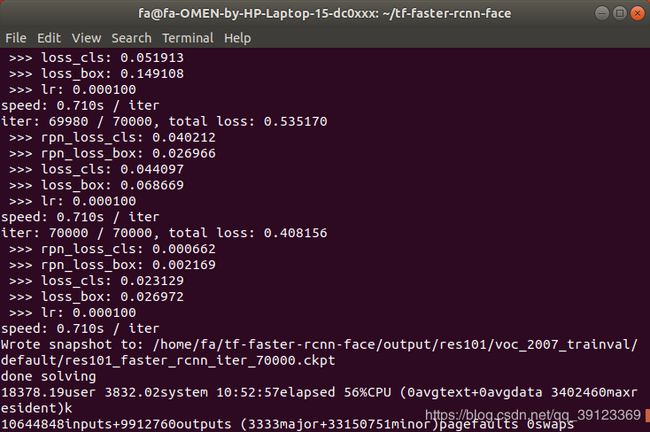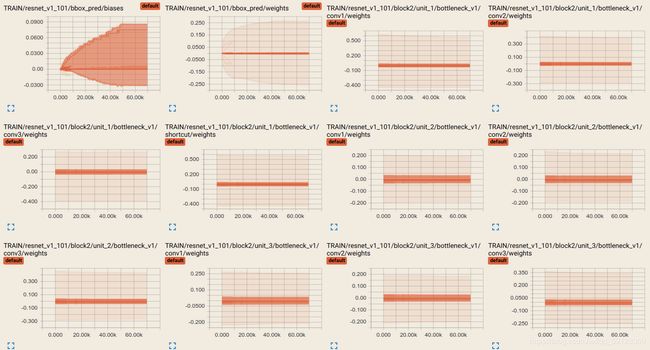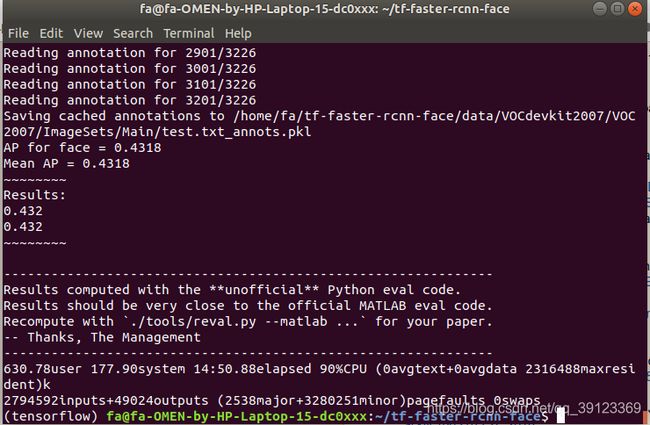应用 WIDER FACE数据集 训练Faster R-CNN,进行人脸检测
上一篇:Faster R-CNN Github源码 tensorflow GPU下demo运行,训练,测试,验证,可视化。
本博文的测试环境都是与上一篇的相同,唯一的区别是tensorflow-gpu版本变为1.8.0。
其实,tensorflow-gpu1.7.0/1.8.0亦可运行。
应用的Faster R-CNN源码为:endernewton
本博文分为以下四章节:
- WIDER FACE数据集准备
- 创建WIDER FACE数据集读取路径,修改源码数据接口
- 训练网络
- 测试,得出mAP
一、WIDER FACE数据集准备
1.点击:http://mmlab.ie.cuhk.edu.hk/projects/WIDERFace/,进入网页,下载如下两个数据集和数据集注解。或者点击如下文字,进入百度网盘下载。
- WIDER Face Training Images
- WIDER Face Validation Images
- Face annotations
2.将下载的三个zip压缩包文件放在新建的一个文件夹,进行解压。
WIDER_train和WIDER_val文件夹下的是62个场景下的.jpg格式图片。
wider_face_split文件夹下的是训练、测试、验证数据集的注释文件。打开readme.txt,查看ground truth的格式:
x1, y1, w, h, blur, expression, illumination, invalid, occlusion, pose。
x1,x2左上角坐标,w,h表示ground truth的宽长,后面这些参数就不用理了(blur人脸模糊程度,expression..)。
3.制作VOC2007格式数据(VOC2007数据集格式,点击查看)
准备条件:安装有opencv,应用指令:pip install opencv-python 安装。
1)获取训练数据集的路径
file_path = "/home/fa/Documents/WinderFace/wider_face_split/wider_face_train_bbx_gt.txt"
image_path = "/home/fa/Documents/WinderFace/"
num_line = 0
with open(file_path) as fr:
image_name = fr.readline()
while image_name:
line_dict = image_name.split(".")
if line_dict[-1].strip("\n") == "jpg":
with open(image_path + "image_path.txt", mode='a') as fw:
fw.write(image_name)
image_name = fr.readline()file_path:训练数据集的注释文件路径
image_path:训练数据集各图片的路径保存位置
最终生成image_path.txt文件。
2)更改图片名字(其实是重新生成新的图片):
import cv2
img_path = "/home/fa/Documents/WinderFace/WIDER_trainl/images/"
file_path = "/home/fa/Documents/WinderFace/img_test_path.txt"
img_store_path = "/home/fa/Documents/WinderFace/image_train"
img_num = 12880
with open(file_path) as fr:
line = fr.readline()
print(line)
while line:
line = line.strip("\n")
img_num = img_num + 1
print(img_path + line)
img = cv2.imread(img_path + line)
if image.data:
print(img_store_path + "{:05d}.jpg".format(img_num))
cv2.imwrite(img_store_path + "{:05d}.jpg".format(img_num), img)
else:
print("loading image appearing error!")
print("The num of image: %d" % img_num)
line = fr.readline()3)生成注解文件:
file_path = "/home/fa/Documents/WinderFace/wider_face_split/wider_face_train_bbx_gt.txt"
store_path = "//home/fa/Documents/WinderFace/Annotations/"
image_index = 0
with open(file_path) as fr:
image_name = fr.readline()
while image_name:
line_dict = image_name.split(".")
if line_dict[-1].strip("\n") == "jpg":
image_index = image_index + 1
print(image_name)
objs = fr.readline()
obj_num = int(objs.strip("\n"))
with open(store_path + "{:05d}.txt".format(image_index), mode='a') as fw:
fw.write(str(obj_num))
fw.write("\n")
for i in range(obj_num):
line = fr.readline()
with open(store_path + "{:05d}.txt".format(image_index), mode='a') as fw:
line = line.strip("\n").split(" ")
bbox_gt = line[:4]
bbox_gt = bbox_gt[0]+" "+bbox_gt[1]+" "\
+str(int(bbox_gt[2])+int(bbox_gt[0]))+" "+str(int(bbox_gt[3])+int(bbox_gt[1]))
fw.write(bbox_gt)
fw.write("\n")
image_name = fr.readline()4)生成图片序号:
file_path = "/home/fa/Documents/WinderFace/trainval.txt"
with open(file_path, mode='a') as fw:
for image_index in range(12880):
fw.write(str(image_index+1))
fw.write("\n")
数据格式到此制作完毕!
二、创建WIDER FACE数据集读取路径,修改源码数据接口
1.在/home/fa/tf-faster-rcnn/data下新建VOCdevkit/VOC2007文件夹,将上述生成的文件分别拷贝到如下目录:
./VOCdevkit/VOC2007/Annotations(注释文件复制在该文件夹下)
./VOCdevkit/VOC2007/ImageSets/Main/trainval.txt(图片序列号文件)
./VOCdevkit/VOC2007/JPRGImages/(将更名后的12880张图片复制在该文件夹下)
2.为PASCAL VOC数据集创建符号链接
cd $tf-faster-rcnn/data
ln -s $VOCdevkit VOCdevkit20073.更改/home/fa/tf-faster-rcnn-face/lib/datasets/pascal_voc.py文件
主要修改两个地方,分别是:
检测的类型改为:self._class=('__backgroud__', 'face')
读取注释文件def _load_pascal_annotation(self, index)函数改为如下:
def _load_pascal_annotation(self, index):
"""
Load image and bounding boxes info from XML file in the PASCAL VOC
format.
"""
filename = os.path.join(self._data_path, 'Annotations', index + '.txt')
# tree = ET.parse(filename)
# objs = tree.findall('object')
# if not self.config['use_diff']:
# # Exclude the samples labeled as difficult
# non_diff_objs = [
# obj for obj in objs if int(obj.find('difficult').text) == 0]
# # if len(non_diff_objs) != len(objs):
# # print 'Removed {} difficult objects'.format(
# # len(objs) - len(non_diff_objs))
# objs = non_diff_objs
#更改读取注释文件
with open(filename) as fr:
num_line = fr.readline()
face_num = int(num_line.strip("\n"))
num_objs = face_num
boxes = np.zeros((num_objs, 4), dtype=np.uint16)
gt_classes = np.zeros((num_objs), dtype=np.int32)
overlaps = np.zeros((num_objs, self.num_classes), dtype=np.float32)
# "Seg" area for pascal is just the box area
# seg_areas = np.zeros((num_objs), dtype=np.float32)
# Load object bounding boxes into a data frame.
num_objs = [obj for obj in range(num_objs)]
for ix, obj in enumerate(num_objs):
box_gt = fr.readline()
box_gt = box_gt.strip("\n").split(" ")
x1 = float(int(box_gt[0]))
y1 = float(int(box_gt[1]))
x2 = float(int(box_gt[2]))
y2 = float(int(box_gt[3]))
cls = self._class_to_ind["face"]
boxes[ix, :] = [x1, y1, x2, y2]
gt_classes[ix] = cls
overlaps[ix, cls] = 1.0
# seg_areas[ix] = (x2 - x1 + 1) * (y2 - y1 + 1)
overlaps = scipy.sparse.csr_matrix(overlaps)
return {'boxes': boxes,
'gt_classes': gt_classes,
'gt_overlaps': overlaps,
'flipped': False,
'seg_areas': 0}
另:数据集中的注释有些地方是错的,需要在imdb.py文件的def append_flipped_images(self)函数增加三行代码:
def append_flipped_images(self):
num_images = self.num_images
widths = self._get_widths()
for i in range(num_images):
boxes = self.roidb[i]['boxes'].copy()
oldx1 = boxes[:, 0].copy()
oldx2 = boxes[:, 2].copy()
boxes[:, 0] = widths[i] - oldx2 - 1
boxes[:, 2] = widths[i] - oldx1 - 1
#增加判断,因为注释有错
for b in range(len(boxes)):
if boxes[b][2] < boxes[b][0]:
boxes[b][0] = 0
assert (boxes[:, 2] >= boxes[:, 0]).all()
entry = {'boxes': boxes,
'gt_overlaps': self.roidb[i]['gt_overlaps'],
'gt_classes': self.roidb[i]['gt_classes'],
'flipped': True}
self.roidb.append(entry)
self._image_index = self._image_index * 2三、训练网络
1.进入/home/fa/tf-faster-rcnn/data文件夹:
./experiments/scripts/train_faster_rcnn.sh 0 pascal_voc res101训练过程需要的条件,参考上一篇博文。
total loss 10K次以后一直在波动,并没又很好的减少,遇到了瓶颈!
2.人脸检测效果
四、测试得出mAp
mAP...
待续补充:



